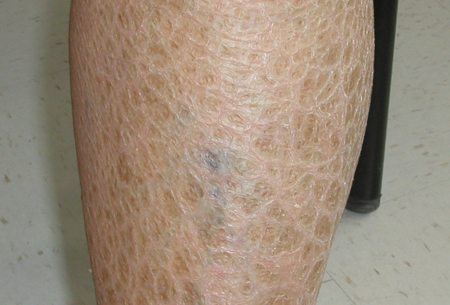Summary
Definition
History and exam
Key diagnostic factors
- scaling
- skin changes at birth (in congenital ichthyosis)
- onset in infancy (in ichthyosis vulgaris and X-linked ichthyosis)
- adult onset (in acquired ichthyosis)
- male sex
- family history of ichthyosis
Other diagnostic factors
- history of atopy
- history of lymphoma, diabetes mellitus, systemic lupus erythematosus
- use of clofazimine, lipid-lowering agents, or butyrophenone
- alopecia and ectropion in lamellar ichthyosis
- cryptorchidism and corneal opacities
- deafness, intellectual disability, limb defects, epilepsy, short stature
Risk factors
- positive family history
- parental consanguinity
- use of clofazimine, lipid-lowering agents, or butyrophenone
- history of lymphoma, diabetes mellitus, systemic lupus erythematosus
Diagnostic tests
1st tests to order
- skin biopsy
- serum cholesterol sulfate
- lipoprotein electrophoresis
- steroid sulfatase activity
Tests to consider
- serum phytanic acid
- genetic testing
- CT scan
- serum glucose
- antinuclear antibody
Treatment algorithm
primary (genetic)
secondary (acquired)
Contributors
Authors
Brittany Craiglow, MD
Associate Adjunct Professor of Dermatology
Yale University
New Haven
CT
Disclosures
BC declares that she is a member of the Foundation for Ichthyosis and Related Skin Types Advisory Board. BC is an author of a reference cited in this topic.
Acknowledgements
Dr Brittany Craiglow would like to gratefully acknowledge Dr Timothy Patton, a previous contributor to this topic.
Disclosures
TP declared that he had no competing interests.
Peer reviewers
David Cassarino, MD, PhD
Assistant Professor
Department of Pathology and Laboratory Medicine
University of California
Los Angeles
CA
Disclosures
DC declares that he has no competing interests.
Thierry Simonart, MD, PhD
Physician
Department of Dermatology
Erasme University Hospital
Brussels
Belgium
Disclosures
TS declares that he has no competing interests.
Peer reviewer acknowledgements
BMJ Best Practice topics are updated on a rolling basis in line with developments in evidence and guidance. The peer reviewers listed here have reviewed the content at least once during the history of the topic.
Disclosures
Peer reviewer affiliations and disclosures pertain to the time of the review.
References
Key articles
Oji V, Traupe H. Ichthyoses: differential diagnosis and molecular genetics. Eur J Dermatol. 2006;16:349-359. Abstract
Shwayder T. Disorders of keratinization: diagnosis and management. Am J Clin Dermatol. 2004;5:17-29. Abstract
Vahlquist A, Ganemo A, Virtanen M. Congenital ichthyosis: an overview of current and emerging therapies. Acta Derm Venereol. 2008;88:4-14. Abstract
Reference articles
A full list of sources referenced in this topic is available to users with access to all of BMJ Best Practice.

Differentials
- Asteatotic dermatitis (eczema craquele)
- Atopic dermatitis
- Psoriasis
More DifferentialsGuidelines
- Ichthyosis
- Consensus recommendations for the use of retinoids in ichthyosis and other disorders of cornification in children and adolescents
More GuidelinesLog in or subscribe to access all of BMJ Best Practice
Use of this content is subject to our disclaimer